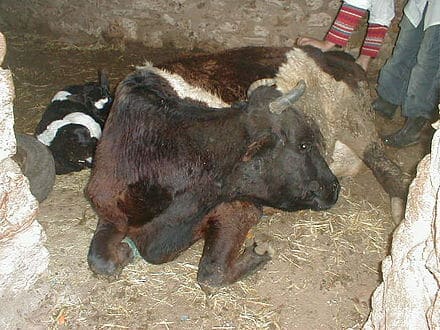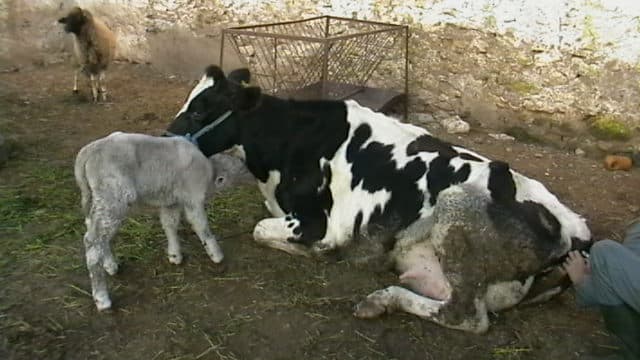Do you have pregnant sheep, goats or cows that fall sick before or after delivery? Saliva drips out of their mouth, they stop defecating or urinating, they find it difficult to stand or walk. The cause might be milk fever. Read to find out more.
Milk fever or hypocalcemia arises when animals are unable to mobilise sufficient calcium from the bones or diet when there is high demand for calcium, leading to low blood calcium level. Calcium is in high demand during late pregnancy and some days after birthing. For cows, milk fever mainly occur after birth but for goats and sheep it mainly occur before birth, during late pregnancy period (i.e. 6 weeks before birthing). Occurrence after birth isn’t common in sheep and goats.
Generally, milk fever can occur at any time from 6 weeks before to 10 weeks after birthing. Milk fever can also occur when certain compounds in feed known as oxalates bind up calcium.
To meet calcium requirement, animals first take it from the blood, then from their diet and bone reserve. But during this critical period, their body will take all the calcium from the blood but cannot take those from the diet or bone reserve fast enough to meet demand. As a result there will be calcium deficiency in the blood and this can be deadly.
Milk fever is more common in older animals than younger ones because older animals mobilize calcium from the bone less efficiently. Also animals with 2 or more babies are at greater risk.
Symptoms of Milk Fever
The following symptoms will help you know if your livestock has milk fever:
1. affected animal won’t be able to stand or move properly. They move stiffly.
2. They will have reduced appetite
3. Animal will feel cold to touch
4. Salivation
5. Constipation
6. Bloat (swelling up of stomach)
7. Muscle tremors (muscle vibration) are more common in goats than sheep

Pic 1: Typical milk fever posture; cow in sternal recumbency with its head tucked into its flank.
The clinical signs of milk fever can be divided into three distinct stages:
Stage 1
The animal can move but show signs of hypersensitivity and excitability such as restlessness, tremors (some part of the body vibrate), ear twitching, head bobbing, and mild ataxia (trouble walking and maintaining balance). Many cows at this stage protrude their tongues when stimulated around the head. If not treated, symptoms usually progress to stage 2.
Stage 2
Animal can no longer stand and present in sternal recumbency (they lie on the ground as shown in the picture above and below). Heart beat becomes faster and animal appear dull, have dry muzzles, cold extremities (eg cold ears, legs) and a lower than normal body temperature. Smooth muscle paralysis can cause bloat, and the inability to urinate or defecate. Cows often tuck their heads into their flanks as shown in the picture above.
Stage 3
Lateral recumbency (the animal lie on its side), muscle flaccidity (the muscles become soft and are easily stretched), unresponsiveness to stimuli (they won’t respond if you touch them), and loss of consciousness progressing to coma. Heart rate can approach 120 bpm, with peripheral pulses becoming undetectable. If untreated the animal will die.
The above symptoms are clinical symptoms (meaning that you can notice them). But there are subclinical symptoms that are not noticeable except some tests are done. Animals with subclinical milk fever can stand and behave normal, but they will be susceptible to diseases like mastitis, placenta retention, uterine infections, endometritis, uterine prolapse, displaced abomasum etc.
Picture 2: Cow lying in sternal recumbency (with sternum in contact with the ground).
How to Prevent Milk Fever
1. Reduce potasium intake. Feed high in potasium often binds calcium. Beware when you fertilize pasture with potasium fertilizer.
2. For cows, restrict calcium intake before birth and increase it after birth. This will fasten calcium release from the bone after birth. But for goat and sheep this isn’t neccessary. Continue meeting their daily calcium requirement with mineral licks.
3. Milk fever can start suddenly within 24 hours after a period of stress. Such stress can be due to sudden change of feed, sudden change in weather, short periods of fasting, transport stress etc.
4. Supply recommended calcium and phosphorus level in the feed. You can get it from a nutrient requirement table from National Research Council nutrient requirements.
5. It has been discovered that milk fever can be effectively treated and/or prevented by feeding dairy cows a diet containing substantial amounts of negative ions (i.e., anionic salts). This diet should be started 14 to 21 days before birthing day. This diet helps maintain healthy levels of blood calcium and also helps the body to more easily mobilize calcium from the bones and diets. An example of such diet is shown below (all % are by weight):
calcium sulfate: 5 to 10%
ammonium salt: not more than 10%
Elemental sulfur: 1.25% to 7.5%
Distillers dried grains with solubles: 5 to 25%
wheat midds: 25 to 45%
Sugar cane molasses: 2.5% to 10%
Flavor additives
Trace mineral mix
Vitamin A, D and E
And of course, you can replace distillers dried grains with solubles and wheat midds with soybeans/groundnut cake and wheat offal etc.
How to Treat Milk Fever
Thankfully, the animals usually recover fast when treated, even in advanced cases.
If the animal cannot stand, you need to act fast because death is not far. You or a vet should give calcium directly into the blood stream through the vein (Intravenously). The calcium is usually given as calcium borogluconate (50–150 mL of a 23% solution for goats and sheep. Use 500ml for cows). Calcium-containing products that also contain phosphorus and magnesium, as well as dextrose, can also be important.
When she recover and is able to stand, continue to give calcium but this time, under the skin. Do so until she could eat well and make sure to always give trace mineral mix. This follow up treatment is very important otherwise milk fever will strike again.
NOTE: Giving calcium intravenous should be done with care. It should be diluted and given over a period of 10 minutes. If not excess calcium will stop the heart and lead to death. Dilute by adding 50–150 mL of a 23% calcium borogluconate or gluconate solution to 1 L of a 5% dextrose solution and administering this volume over 10 minutes. Monitor the heart beat while giving IV calcium. If it becomes irregular, too fast or too slow, stop and continue when if becomes regular.
If the animal is not yet down or if you suspect or expect milk fever, you can give calcium subcutaneously (under the skin) and orally (as lime water mixed with jaggery or sugar). Calcium solutions under the skin are irritating, so when administrating subcutaneously, the total volume should be divided into 2 or 3 equal quantities and administered to different parts of the body. Repeat after 24 hours.
You can also give dextrose injection for energy along with calcium. This will take care of any case of pregnancy toxemia (ketosis). Also important is multivitamin injection.
Before calcium injection was employed, an effective way to treat milk fever in cows was to inflate the udder using a pneumatic pump. The increased pressure created in the udder pushed the calcium in the udder back into the bloodstream of the cow. The downside here is that it can complicate mastitis.
NOTE: Do not give calcium intravenously to cows with subclinical milk fever. It will only decrease their blood calcium level. Subclinical hypocalcemia is rarely diagnosed in commercial farms because it is expensive to diagnose. So for cows, you can just give an oral calcium bolus immediately after calving and a second bolus 12 hours later to high producing cows (two or more lactations). For sheep and goats, give them mineral mix containing limestone throughout pregnancy.

Leave a Reply